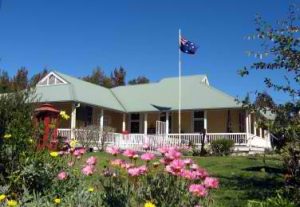
Myf Thompson 'keeping calm and carrying on'.
Following their mandatory closure to the public, due to COVID-19, the Batemans Bay Heritage Museum was able to undertake extensive work behind the scenes. We spoke to the Myf Thompson about the activities undertaken by the museum's very dedicated volunteers during this period.
M&G: The Batemans Bay Heritage Museum volunteers have been very busy during the museum’s closure; can you describe what you’ve been up to behind the scenes?
MT: We used social and print media to advise the public of continuing research and welcomed any enquiries. Six grant applications were made, and some policy documents were reviewed. We attended online workshops relating to governance and community engagement. Lots of big building maintenance jobs have been spread out over weeks instead of days. We re-stocked our two secondhand bookshop spaces; with appropriate social distancing and hand sanitiser provided, these have started operating whilst the museum itself is closed.
M&G: What have been the challenges for the museum during the pandemic?
MT: We recognised early on that active volunteers enjoy our structured social environment, and we worked hard via regular emails, cartoons and newsletters to keep them motivated and engaged with us when weeks passed without physical connection. Just so with our other members, public ‘followers’ on our website, Facebook and Instagram.
We suffered a robbery during enforced closure. Funds saved for a new major external exhibit have been reallocated to upgrade security and – where possible – replace stolen items, thus postponing the new rural display for at least 6 months. We received Government small business relief funding which helped offset 6 months with no visitors but we still have bills to pay.
M&G: Have you discovered anything new in or about the museum or collection whilst working behind the scenes these past few months?
MT: Time to revisit displays clarified our raison d’être and freshened our storytelling approach. De-accessioning and acquisitions took place. We finally had time to sort through boxed documents. Findings included a local wages ledger from 1964; we posted extracts on local resident sites naming employees and wages, noting we hoped they had advised the ATO as earnings were now in the public domain!
"Time to revisit displays clarified our raison d'être and freshened our storytelling approach."
M&G: You’ve undertaken a lot of research into local history. Is there a particular anecdote or insight you’ve recently discovered?
MT: Our Cemeteries Group (3 max) continued to don boots, document and geo locate cemeteries and burial sites pre and post bushfires and virus. Opportunities for contextual research arise all the time, for example a series of headstones where non-familial deaths and a range of ages occurred over a single 3 month period.
M&G: Have you started to plan the museum’s re-opening?
MT: We started planning for re-opening immediately after we were forced to close, mapping out a volunteer PP roster and schedule to take advantage of ‘no public’ access to do big maintenance and exhibition design jobs. Winter being a traditionally slow visitor period, we have invested in garden design for a welcoming spring show around the grounds. Reminders to book for the end of 2020 and 2021 have been sent to coach companies and local groups planning guest speakers. We noted the NSW Government’s advice regarding re-opening of museums, but decided on a later date of July 1 for ourselves to ensure all our volunteers and public feel safe in attending.
M&G: The new display It’s All About the Book is being installed now. Can you tell us about the exhibition and what people can look forward to seeing once the museum is re-opened?
MT: We have one large and one small space always dedicated to temporary displays. In the smaller space Debra Hope, our bookshop manager, has curated It’s All About the Book, featuring videos on book construction and decoration, hands-on examples from our own collection, key publishers like Penguin, and a very comfortable chair for browsing readers. Our large space currently has a touring Cook250 display which will be replaced in October with locally curated At Peace. Symbolism and Ritual, addressing societal changes to death from mid-Victorian to current times.




